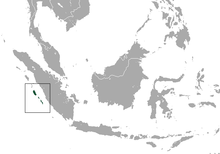Pig-tailed langur
| Pig-tailed langur[1] | |
|---|---|
| Scientific classification | |
| Kingdom: | Animalia |
| Phylum: | Chordata |
| Class: | Mammalia |
| Order: | Primates |
| Family: | Cercopithecidae |
| Subfamily: | Colobinae |
| Genus: | Simias Miller, 1903 |
| Species: | S. concolor |
| Binomial name | |
| Simias concolor Miller, 1903 | |
 | |
| Pig-tailed langur range | |
The pig-tailed langur (Simias concolor, monotypic in genus Simias) is a large Old World monkey, endemic to several small islands off the coast of Sumatra in Indonesia. Its face is black, its fur is blackish-brown and it has a relatively short tail. It is a diurnal species, feeding in small groups in the rainforest canopy on leaves, and to a lesser extent, fruit and berries. Little is known of its natural history, but it is heavily hunted, its populations have been declining rapidly and the International Union for Conservation of Nature has assessed its conservation status as being "critically endangered". It has been included on a list of the World's 25 Most Endangered Primates.
Description
The pig-tailed langur is a large and rather heavily built Old World monkey, adapted to climbing with its long arms. Its fur is black-brown, and its hairless face is also black. It is the only monkey in the subfamily Colobinae to have a relatively short tail; the tail is only slightly furred and is only 15 cm long. The short nose is pointed upward. The pig-tailed langur reaches a full grown length of approximately 50 cm (20 in) and a weight of 7 kg (15.5 lbs). Traditionally, it has been placed in the genus Nasalis together with the proboscis monkey - a treatment still preferred by some.[3]
Distribution
This primate lives only on the Mentawai Islands, where it is known as simakobou in Siberut and simasepsep on the southern islands of Sipura, North Pagai, and South Pagai. Two of these islands, North- and South-Pagai, are its main range. It is a diurnal and arboreal rain forest dweller, rarely coming to the ground. It lives in small groups (3 to 8 animals), which consist of a male, one or more females, and their offspring. Its diet consists mainly of leaves and, to a lesser extent, fruits and berries. Nothing of its reproduction is known.[2]
Status
The species is threatened by destruction of its habitat, hunting for food and capture for the pet trade and its population has been declining rapidly. In the Pagai Islands, it is estimated that twice as many animals are killed by hunters than are replenished through breeding. The International Union for Conservation of Nature has assessed its conservation status as "critically endangered",[2] and it is considered to be one of "The World's 25 Most Endangered Primates."[4]
Subspecies
- Genus Simias
- Pig-tailed langur, Simias concolor
- Simias concolor concolor
- Simias concolor siberu
- Pig-tailed langur, Simias concolor
References
| Wikispecies has information related to: Simias |
| Wikispecies has information related to: the pig-tailed langur |
- ↑ Groves, C.P. (2005). Wilson, D.E.; Reeder, D.M., eds. Mammal Species of the World: A Taxonomic and Geographic Reference (3rd ed.). Baltimore: Johns Hopkins University Press. p. 175. OCLC 62265494. ISBN 0-801-88221-4.
- 1 2 3 Whittaker, D. & Mittermeier, R. A. (2008). "Simias concolor". IUCN Red List of Threatened Species. Version 2008. International Union for Conservation of Nature. Retrieved 4 January 2009.
- ↑ Bradon-Jones, D., A. A. Eudey, T. Geissmann, C. P. Groves, D. J. Melnick, J. C. Morales, M. Shekelle, and C. B. Stewart. 2004. Asian primate classification. International Journal of Primatology. 23: 97-164.
- ↑ Mittermeier, R.A.; Wallis, J.; Rylands, A.B.; Ganzhorn, J.U.; Oates, J.F.; Williamson, E.A.; Palacios, E.; Heymann, E.W.; Kierulff, M.C.M.; Long Yongcheng; Supriatna, J.; Roos, C.; Walker, S.; Cortés-Ortiz, L.; Schwitzer, C., eds. (2009). "Primates in Peril: The World's 25 Most Endangered Primates 2008–2010" (PDF). Illustrated by S.D. Nash. Arlington, VA.: IUCN/SSC Primate Specialist Group (PSG), International Primatological Society (IPS), and Conservation International (CI): 1–92. ISBN 978-1-934151-34-1.
